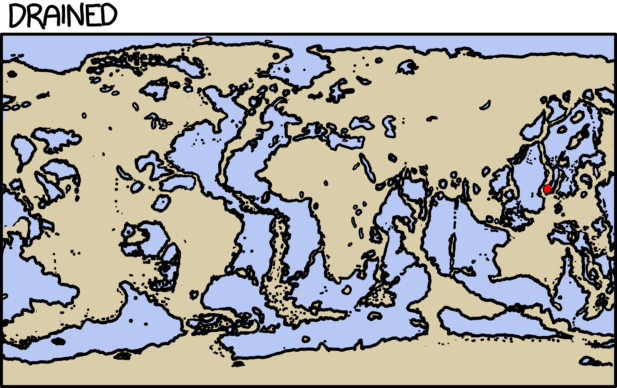A simulation of draining the world's oceans by pulling a hypothetical "plug" in the Marianas Trench, inspired by the work of Randall Munroe of XKCD
Other oceans aren't necessarily deeper than the Pacific, they just get landlocked and stop draining
Many lakes will likely stick around since they are fed from rivers and direct rainfall.
The continents drift, but not that much, over this time span.
The plug is 10m in diameter (that's metres, for the Americans).
No, there's not actually a plug...
Other oceans aren't necessarily deeper than the Pacific, they just get landlocked and stop draining
Many lakes will likely stick around since they are fed from rivers and direct rainfall.
The continents drift, but not that much, over this time span.
The plug is 10m in diameter (that's metres, for the Americans).
No, there's not actually a plug...
From LiveScience by Mindy Weisberger
What might it look like if you "pulled the plug" in the Mariana Trench — the planet's deepest spot — and drained the water from all the oceans in the world?
A recent time-lapse video portrays that speculative scenario using real data, shown in an animation by Ryan Brideau, a masters candidate in geospatial visualization and analysis at the University of New Brunswick in Canada.
In the animation, posted to Reddit, a flat map of Earth reveals coastlines expanding and land bridges appearing between continents and former islands as the seas shrink. Meanwhile, islands and land masses emerge from the oceans as the water drains away, over a period of nearly 3 million years.
Drainage in the Pacific Ocean where the trench is located continues to the end of the animation — which lasts about 30 seconds — while other large bodies of water quickly become landlocked and cease to drain at all, Brideau wrote on Reddit.
Drain the Oceans by Randall Munroe
He explained that he first encountered the idea of an imaginary giant "plug" in the deepest part of the ocean — and what might happen if that plug were removed — in the book "What If? Serious Scientific Answers to Absurd Hypothetical Questions" (Houghton Mifflin Harcourt, 2014) by Randall Munroe, the writer and illustrator behind the exquisitely nerdy (and humorous) science comic xkcd.
Munroe, who also wrote about the intriguing question in a blog post, envisioned a plug measuring about 33 feet (10 meters) in diameter, with the water somehow vanishing at the drainage point and materializing on Mars (in case you were wondering where all that liquid would end up).
He estimated in the post that it would take hundreds of thousands of years for significant drainage to happen, with sea levels dropping at "less than a centimeter a day," he wrote.
Brideau was intrigued by the challenge of re-creating an animated version of the model that Munroe used for that scenario, the researcher told Live Science in an email.
He located a visualization of draining oceans created by NASA scientists in 2008, but those researchers took "a major shortcut" by not factoring in the connections between oceans, Brideau explained.
"That makes a big difference in terms of difficulty, and I wanted to see how close I could get to Randall's result myself," Brideau said in the email.
In this draining scenario, California surfers would have to travel a lot farther to catch those gnarly waves.
Credit: Ryan Brideau
Creating a visualization like this requires high-resolution elevation maps of land structures above and below sea level, along with location data for all the major water bodies on Earth, Brideau explained.
"These need to be in 'raster' form, which is simply an image, but instead of each pixel recording color, they record elevation or the presence/absence of water," he said.
The model then estimated drainage in the oceans, adjusting for changes in connections between bodies of water as they become isolated by emerging seafloor structures and cease to drain, Brideau explained.
"The hard part is calculating the remaining water at each iteration," he said.
"You have to figure out which areas of water in the previous step were 'drainable' and subtract them from the remaining water, but leave the water bodies that were untouched in place. You also have to subtract any landforms that have started sticking out of the water.
"The big variable that I didn't take into account is the weather, which might cause some water bodies to start to dry out if their primary source of incoming water is currently the ocean," Brideau told Live Science.
"But in reality, the weather would also be changing, so it's hard to predict," he said.
His model visualized dramatic changes to the continental coastlines in the first 200,000 years.
Toward the end of the animation — nearly 3 million years after the plug was pulled — only the Pacific Ocean is still flowing into the drainage hole in the trench.
At this point, every frame in the animation represents a drop in ocean depths of about 33 feet (10 m) Brideau wrote on Reddit.
"I think the visualization is captivating because it plays out a doomsday scenario at a massive scale, and yet is still relatable. Everyone has drained a bathtub and knows how long that takes, and so it's fun to think of doing that for something the size of the ocean," he told Live Science in an email.
"I distinctly remember as a kid my brother and I pulling on a rope at the beach that we were convinced was connected to a giant plug at the bottom. It's just a fun thing to think about," Brideau said.


No comments:
Post a Comment